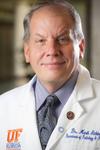Research Terms
Center for Immunology and Transplantation (HSC)
| Director |
Clayton Mathews |
| Phone | (352) 273-7838 |
| Website | https://immunology.ufl.edu/ |
| Mission | The Center for Immunology and Transplantation provides an environment for multidisciplinary approaches to questions in immunology and transplantation. Investigators associated with the CIT bring together biochemical, pharmacological, molecular, biological and clinical expertise to study the immune response and to create novel ways to modify its activity. Current work focuses on the nature of autoimmunity, organ transplantation, the role of the immune system in infectious diseases, as well as on development of therapies which circumvent disease. |
This 3D bio-printed liver tissue model, which exhibits the functions of a human liver, tests for and predicts the liver toxicity of new drug therapies. Current approaches used in testing the potential liver toxicity in a compound during the drug development process are animal models and in vitro cell cultures. Animal models often fail to predict toxicity in humans, leading to costly clinical development failures, black box warnings, or withdrawal of drugs from the market. In vitro cultures lack the complexity of live tissue necessary for proper function and accurate responses. There is a critical need for technologies capable of predicting the toxicity of compounds while increasing the pace and lowering the costs of drug development.
Researchers at the University of Florida have developed a 3D bio-printed liver tissue model for toxicological investigations. The 3D-printed liver model has a function comparable to a human liver, accurately predicting the toxicity of drug compounds. It can also potentially be used for drug metabolism studies, identifying disease markers, assessing gene therapy vectors, screenings, and more.
Tests and predicts for liver toxicity of compounds found in drug therapies
This 3D bio-printed liver tissue model comprises a mixture of liver, hepatocyte cells, endothelial cells, extracellular matrix material, and a micro gel medium made from liver-specific culture. Growth media, containing either known toxic or potential therapeutic compounds, is infused into the liver tissue model to analyze compound toxicity. It will induce cellular toxicity or, alternatively, repair cells, allowing for analyzation of any changes to the model. This model also shows a stable production of albumin and urea levels and has a gene expression profile of typical human liver cells. Additionally, its enzymatic cell function is 70 to 80 percent of human liver cells.


































